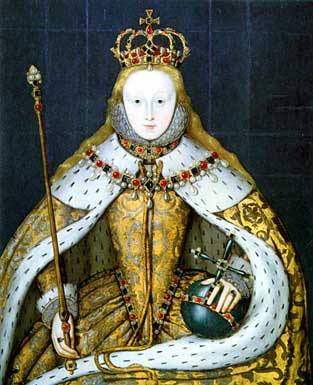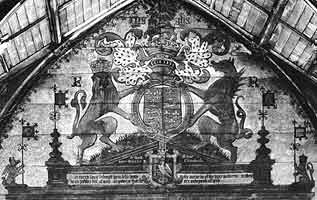|
|
|
|
|
|
|
|
|
|
|
|
|
|
|
|
|
|
|
|
|
|
|
|
 |
|
|
|
|
|
|
|
|
|
|
|
|
|
|
|
|
 |
|
|
|
|
|
|
Queen
Elizabeth I was the only child of Henry VIII and
his second wife Anne Boleyn. Elizabeth's
long reign was considered the golden age in English history but it was not without
its moments of controversy. The first major task that greeted the new queen
was the settlement of England's tormented religious affairs. In order to bring
about a peaceful compromise, Elizabeth chose the middle road as a means of restoring
her countries fractured religious system. |
|
|
|
|
|
|
Coronation
portrait of Elizabeth I |
|
|
|
|
|
|
|
|
|
|
A
new Act of Supremacy (1559) was created that pronounced the Queen as "Supreme
Governor" over the Church of England, a title that Catholics throughout
the land found more tolerable. The Act of Uniformity (1559) restored Edward
VI's Book of Common Prayer, which had undergone certain calculated changes
to decrease its offensiveness to Catholic sensibilities. This legislation
embraced Protestantism and became one of the most decisive factors in the
formation of modern Anglicanism. To supplement these injunctions of 1559
"A Declaration of Certain Principal Articles of Religion" was presented
which firmly suppressed religious images within the church. "Last of
all, as I do utterly disallow the extolling of images, relics and feigned
miracles, and also all kind of expressing God invisible in the form of an
old man, or the Holy Ghost in the form of a dove, and all other vain worshipping
of God, devised by men's fantasies..." Elizabeth I desired a return
to order and control over church affairs and while she did not stop the
destruction of religious imagery, her government did attempt to direct it
into more controllable channels. For example, in 1560 she issued a proclamation
against the abuse and defacing of tombs and monuments as a means of showing
respect for the memory of the dead. |
|
|
|
|
|
|
|
|
|
|
|
|
|
|
|
|
|
 |
|
|
|
|
The
destruction of sacred religious images paralleled a rise in the scared images
that began to appear of Elizabeth, the Virgin Queen. Her royal coat of arms
was places in the archways and tympanums of parish churches as an emblem of
honor that required civic veneration. A social change was occurring as the growth
of secular art began to replace the public's desire for the artistic props of
religious imagery. The reign of Elizabeth had stabilized the tumultuous religious
forces that had plagued England during much of the Tudor monarchy and gave England
a sense of religious peace of freedom held within prescribed limits. |
|
|
|
|
|
|
|
|
|
|
|
|
|
|
|
|
Painting
of the arms of Elizabeth I replacing teh tympanum Doom Painting at St. Margaret's
Church in Tivetshall, Norfolk. |
|
|
|
|
|
|
|
 |
|
|
|
|
|
|
|
|
|
|
|
|
 |
|
|
 |
|
|
|
|
|
|
|
 |
 |
 |
 |
 |
 |
 |
 |
 |
 |
 |
 |
 |
 |
 |
 |
 |
 |
 |
 |
 |



